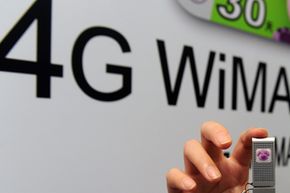Cell-phone Network Technologies: 4G
The "4G" cell phone has been around for years – at least since 2006, if you go by Sprint's definition of 4G [source: Segan]. That original 4G network used a technology called WiMAX, one of several approaches to 4G implementation. Like previous generations, 4G is not a standardized designation. It's simply the next step up in speed.
All the top service providers have some type of 4G network now, in various stages of development and coverage, built on one of three main cellular-access technologies: LTE, HSPA+, and WiMAX [source: Gaylord].
Advertisement
WiMAX is somewhat unique among cell phone access methods in that it's based on 802.16 wireless standards – aka wireless broadband Internet which is used for homes and offices. The WiMAX approach takes the second iteration of those standards, 802.16e, which supports mobile access, and applies it to the cell phone realm [source: Phone Scoop]. Transmissions use orthogonal frequency division multiplexing, or OFDM, a method of dividing signal data into multiple channels to speed up delivery and then combining all the bits back into a single unit at the destination [source: 4G Americas]. WiMAX transmission can theoretically top out around 40 Mbps, but in reality it is much less [source: Segan].
HSPA+, on the other hand, is an upgrade to a long-existing approach to cellular: HSPA, or High-Speed Packet Access. HSPA builds on the 3G WCDMA infrastructure, which carries signals in either one or two frequency bands depending on mode [source: Tech FAQ]. In 3G form, HSPA networks have peak data-transfer speeds of 14.4 Mbps [source: 4G Americas]. By using higher-order QAM (quadrature amplitude modulation, which encodes multiple data streams into a single transmission, mimicking increased bandwidth), carriers can achieve HSPA+ speeds of up to 21 Mbps [sources: Tech Target, 4G Americas, Ruddock]. Antenna improvements may further increase HSPA+ transmission rates [source: 4G Americas].
Despite the obvious gains in speed, many in the cell phone world consider both WiMAX and HSPA+ to be transitional technologies [source: Gaylord]. The 4G most people are waiting for is LTE.
